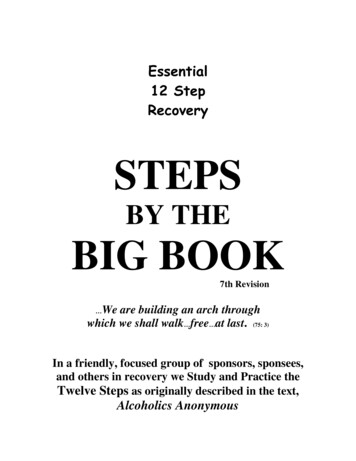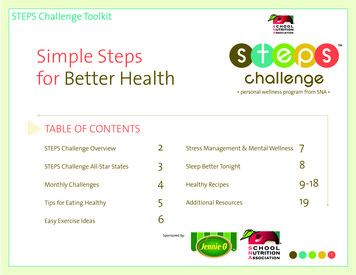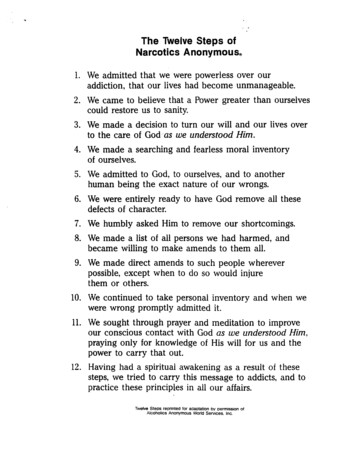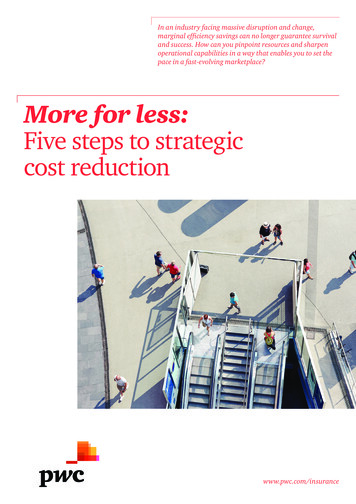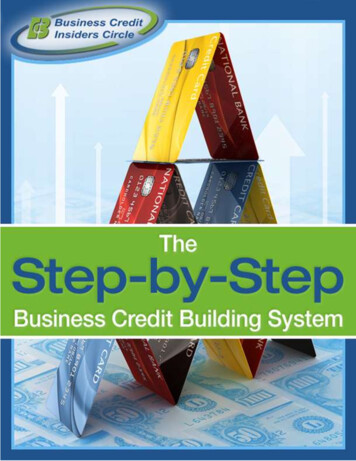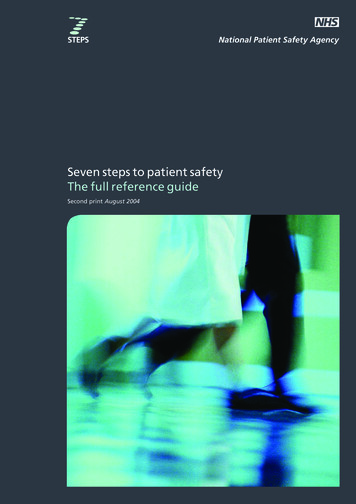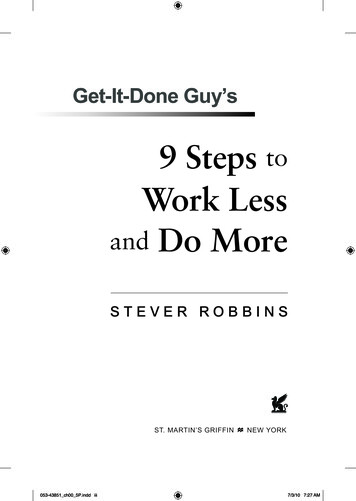
Transcription
Get-It-Done Guy’s9 Steps toWork Lessand Do MoreSTEVER ROBBINSST. MARTIN’S GRIFFIN053-43851 ch00 5P.indd iiiNEW YORK7/3/10 7:27 AM
get-it-done guy’s 9 steps to work less and do more. Copyright 2010 by SteverRobbins. All rights reserved. Printed in the United States of America. For information,address St. Martin’s Press, 175 Fifth Avenue, New York, N.Y. 10010.www.stmartins.comBook design by Kelly S. TooISBN 978- 0- 312- 66261- 5First Edition: September 201010987053-43851 ch00 5P.indd iv6543217/3/10 7:27 AM
STEP 2STOP PROCRASTINATINGWe all procrastinate, and we put off the very things that are mostimportant. What is up with that? When we procrastinate, we doeverything except work less and do more! If we procrastinatedby filling our time with deep, meaningful, soul-enriching activities like spending time with friends, helping children learn skillsthat will prepare them for adulthood, or bowling, I could understand it. But we don’t. We delay what will get us what we want byplaying solitaire or restoring our beloved picture of Elvis afterhumidity has damaged the velvet.In this “Step 2: Stop Procrastinating,” we’ll explore how procrastination comes from things under our control, which meansthe answer to it is also under our control. As tempting as it is tofall back on “Just Do It” running-shoe slogans as the key to success, we’ll find that you can set up the world around you to nudgeyou into action when your brain just isn’t up to the challenge onits own. And when the world isn’t cooperating, you still have waysto retrain your brain so you’ll jump right into action.Procrastination comes from your thinking. We’re going to usethe very thoughts that cause procrastination as the keys to overcoming it and sailing merrily along our way.053-43851 ch01 5P.indd 347/3/10 7:27 AM
STEP 2: STOP PROCRASTINATING35Let’s use me as an example, since I’ve been procrastinatingwriting this chapter for two days. And because I’m hopelesslyself-absorbed. I glance at my computer, its deceptively innocentscreen saver beckoning, “Come to me! Write your book!” Everthe rebellious adolescent, I immediately find reasons to rejectmy electronic master’s seductive command. Thoughts flickerthrough my mind:I have to work on my book.Writing isn’t fun.It’s such a big project, I’ll neverfinish.I would rather be out playing.I have so many other things to do.It won’t be any good.I don’t have the resources topull it off.People won’t respect me if I don’tfinish.I don’t want to work on my book.My sweater really needs to bede-pilled. Right now.These thoughts weigh heavily: “I have to work on my book.”True. And just thinking that sends me into fantasies of all thebad things that will befall me should the work not get done. Iimagine my editor, Emily, in full riding regalia atop a gorgeousthoroughbred, looking down at me in pity tinged with contempt.“We had such high hopes for you,” she says, as I stand emptyhanded in despair. The tragedy of the incomplete manuscript iscomplete as she turns and canters into the sunset, leaving megroveling wretchedly amid the wreckage of my book. So engaging is the daydream that I don’t even remember what I’m putting off.When you’re procrastinating, the procrastination, the excuses,and the daydream are all in your head. If there’s that much creativity swirling around in there, why aren’t you taking action?Who knows? In fact, who cares? All you need is a way to get thingsmoving.I’ll bet there’s a lot you don’t put off. Most people shower,053-43851 ch01 5P.indd 357/3/10 7:27 AM
36GET-IT-DONE GUY’S 9 STEPS TO WORK LESS AND DO MOREbrush their teeth, and get dressed every morning without procrastinating. They just do it. People who cook go shopping weeklyand stock up. They don’t procrastinate, they just do it. And whenit comes to putting on shoes and socks, well, gosh darn it, theyjust put those socks right on their feetsies and leap into the day.The difference is thinking. When you think before you act,you can talk yourself out of anything, no matter how importantit might be.TURN TASKS INTO HABITS TO STOPPROCRASTINATINGThe first step in overcoming procrastination is to turn those recurring tasks you always put off into habits. Think of the thingsyou do every day or every week that you just do without thinkingabout. As for me, I always brush my teeth every day and do thelaundry every week. What makes the things you do on time effortless is not their importance. I can survive months withoutdoing laundry, especially if I don’t care about keeping my friends.Laundry is just not that important. I can get gum infections andlose all my teeth if I don’t brush regularly. Brushing is that important. Yet I treat them equally. I do laundry weekly and I brushdaily. That’s because they’re both habits. Habits are actions westreamline to the point where they’re no longer a decision, they’rejust something we do. They don’t require thought, so we don’tprocrastinate. We just do them.The easiest way to overcome procrastination is to make thingshabits. You can have daily, weekly, monthly, and yearly habits. Ibrush my teeth daily, do laundry weekly, pay bills monthly, anddo spring cleaning yearly. That’s when I find all the socks thatvanish during weekly laundry.Establish a habit by making it regular. Put it on your calendarto remind you. When the time comes, treat it as an appointment.053-43851 ch01 5P.indd 367/3/10 7:27 AM
STEP 2: STOP PROCRASTINATING37A solution many writers use to overcome procrastination isto establish a habit of writing at the same time every day, for thesame length of time. Once the habit is in place, they just crankout the prose. You’d think I would have established a habit a yearand a half ago when I started this book. Yeah, you’d think. Ifyour event in the procrastination Olympics is filling out yourweekly expense reports, pick a day and time to do them—sayThursday at ten—and start them every Thursday at ten. Soonyou’ll be completing these reports as effortlessly as you brush yourteeth before bed. If you don’t make your tasks a habit, you’restuck back with your thoughts, which can derail even the simplest of tasks. Potential habits to develop: checking and responding to e-mail only at specific times, working out, grocery shopping,balancing your checkbook, getting together with friends (perhaps for a regular Sunday brunch), cleaning the living room, doinglaundry. At work, you can build habits around straightening yourdesk, writing regular status reports, checking in with peopleyou’re building relationships with (which I’ll get to in step 8),offering to help your teammates, following up on prospect calls,touching base with customers, and meeting with your manageror the people who report to you.USE BABY CHUNKSSometimes the tasks we procrastinate are big, one-time projects,so turning them into habits just won’t work. Procrastination experts say to break these big projects into tiny chunks and use babysteps to move forward. The first time, I misheard this as “takebaby chunks.” The visual was so disturbing that I knew I had toinvent a real technique to go with this memorable instruction.Taking baby chunks isn’t about breaking your project intopieces, it’s about breaking time into pieces. When there’s an endin sight, it’s easy to buckle down and power through. That’s why053-43851 ch01 5P.indd 377/3/10 7:27 AM
38GET-IT-DONE GUY’S 9 STEPS TO WORK LESS AND DO MOREwe like speed dating. We’ll even talk to someone who doesn’tfloss when we know we can move on in a mere three minutes.When a task seems endless, we’re terrified, because deep down,we fear getting trapped. Marriage has no end point; meditate onthat and despair.With baby chunks, you’ll speed date the task you’ve been procrastinating. Set a time limit (preferably with an actual physicaltimer) and work 100 percent for that much time. Then get upand do something else. From the moment you sit down, you’llknow that in just a few minutes, you’ll be free once again.When I first began writing, I would write for ten minutes andplay games for fifteen. I played more than I wrote. But it gavesteady progress in ten-minute chunks. Every hour included twentyminutes of writing. Over a day, that added up to almost threehours.Over time, I shifted the balance to include more writing.Even so, short chunks of time with a defined end point let merelax enough to get going when the job seemed overwhelming.You can use the same technique for mind-numbingly boring thingslike planning business trips. When you have travel to book, meetings to set up, hotels to reserve, and details to juggle, you can doit ten minutes at a time. Spend the top of each hour comparingfares on a dozen Web sites. By day’s end, you’ll have devoted anentire eighty minutes and be ready for your very first excursionto Sheboygan.Now we know about baby chunks and habits. Let’s make ahabit of baby chunks. If you’re procrastinating several projects atonce, each project becomes an excuse not to work on the other.Report due tomorrow? No time to work on it; I have to work onmy taxes. Taxes due tomorrow? But I really should work on myreport. You need to make sure you’re doin’ chunks with all yourprojects, or else the one that’s not moving forward will becomethe siren that seduces you away from the others.053-43851 ch01 5P.indd 387/3/10 7:27 AM
STEP 2: STOP PROCRASTINATING39USE DAILY ACTION PACKSA Daily Action Pack* is the answer to keeping track of all yourprojects. A Daily Action Pack tells you what you need to do dailyto guarantee progress toward your goals. You can choose a certain amount of time to spend on each project, as we did withbaby chunks, or you can choose some other way to decide a goodday’s contribution. Let’s say you work for Tasty Munchies, Inc.,and have to review the monthly financials from your forty retailstores by the end of the month, twenty days from now. (For some ofus, this would be the most boring thing ever. For you, it’s a thrilling expression of your life’s true purpose.) You must review fortyreports in twenty days. That means, you must review two reportsper day to make your goal. You know if you read your two dailyreports, you’ll finish the project.Gather your major projects and figure out what daily dosewill be enough to move each project forward. It might be a number of pages to write or read, a number of phone calls to make, ora certain amount of time spent each day on a project. Write theseall on your Daily Action Pack. What you’ll end up with is theminimum needed to move everything forward. And you calculated it knowing if you do it daily, you will eventually finish everything.Now that you’ve created your Daily Action Pack, make it ahabit. Every day, pick it up and make sure you run through everyitem on the list. You will keep everything moving, and if you doit first thing every day, you know you’re done for the day as soonas you have finished your Daily Action Pack— even if the wholething only takes half an hour.* Thanks to Scott Wintrip and Jay Perry of jayperry.com, cofounders of theSimply Effective coaching program in which I was first exposed to the DailyAction Pack.053-43851 ch01 5P.indd 397/3/10 7:27 AM
40GET-IT-DONE GUY’S 9 STEPS TO WORK LESS AND DO MORECREATE A WEALTH INVENTORYOne of my favorite ways to procrastinate is by whining. No matter how reasonable my baby chunks are, I can always whine toconvince myself to do something later. My favorite whine is, “Idon’t have what it takes to get this project done.” And gosh darnit, I’ll stretch reality to the breaking point when I’m whining. I’vepostponed a project for hours after whining that I didn’t havequite the right pen. I needed a .38 mm bright blue, gel ink pen.And since I can’t stand listening to whining, I’ll do anything toshut me up. In this case, it meant a trip to the stationery store.Yes, I actually have a codependent relationship with my own procrastination.When you feel like you don’t have what you need to Make ItWork, think again. Though you couldn’t bring a book to yourhigh school finals, life is an open-book test. You have a lifetime’sworth of help, if you remember to use it. The best way to remember is to write it down.What are your life resources? You know people, you havemoney and things, and you have skills. At any moment, you thinkof one or two of these at best. But if you make a wealth inventory, you can jog your memory whenever you need. You neverknow when your ability to act out Poe’s The Raven interspersedwith Seuss’s Horton Hatches an Egg will be just the thing youneed when preparing your presentation on the quarterly numbers for the actuarial group.Get out a piece of paper. Write four column headings: people,money, stuff, and skills. Under each column heading, write inthe people you know, your money, your stuff, and your skills.When filling in people, scour your address book. Write down anyone you could ask for help: high school friends, college friends,teachers, bosses, and that strange-but-nice relative with the pe-053-43851 ch01 5P.indd 407/3/10 7:27 AM
STEP 2: STOP PROCRASTINATING41culiar skin condition you met at your family reunion. Write themall down.In the money column, list your cash, and anything that couldbe turned into cash. List assets you could borrow against, creditcards, and all the ways you could get money if you absolutelyneeded to. We’re not saying you’re going to use any of these resources, just that you have them available.In the skills column, write down everything you’re good at.Sometimes you’ll find you have skills you can apply to a problemin really creative ways. When you’re postponing a project by bemoaning your lack of resources, get out your wealth inventory.Browse it. Ponder, pontificate, explore, think, and research. Bringit all to mind and let your mind begin to make connections tofigure out how you could use what you already have in gettingthe job done. Your wealth inventory helps you get going againwhen a challenge seems daunting.When a start-up company was searching for a way to highlight its product, the marketing manager found himself very busydoing anything but approaching potential marketing partners fora product launch. He didn’t know any likely partners off the topof his head, and he was scared to cold-call. Then he reviewed hiswealth inventory. A resource was an old directory of trade showsfrom a former job. Seeing that sparked the idea of contacting hiscity’s department of commerce, finding a current directory, andadding promotional speeches and product booths to their launchstrategy.If only I had really looked over my wealth inventory whenprocrastinating by whining about not having the right pen. Whatwould my wealth inventory have told me? Under “skills,” it seemsI can write with any writing implement. Who knew? Under“people,” I know Brent, the pen counter czar at my local stationery story—it’s only a block away. I could ask Brent to bring a053-43851 ch01 5P.indd 417/3/10 7:27 AM
42GET-IT-DONE GUY’S 9 STEPS TO WORK LESS AND DO MOREpen by during his lunch hour. And resources would be the mostembarrassing. I’d have to face the two hundred pens I alreadyown and tell them why I don’t love them anymore and am looking for a replacement. That would be really tough, especiallysince I would have discovered I already have a .38 mm brightblue, gel ink pen. And maybe surveying my inventory would havegently reminded me that I don’t need a 201st pen; I can just startwriting.USE OTHER PEOPLESometimes, even with baby chunks and all your resources linedup, you need to call in the big guns: other people. When otherpeople are counting on us, we’re hard-wired to perform. We giveit noble names like “accountability,” but underneath it’s reallyjust us being scared Mommy won’t love us if we don’t do what wesay. Using other people is also an excuse to create a shared bondwith our other friends who are procrastinating, too. Not to mention having fun sniping together at the few who don’t have thecourtesy to procrastinate, and are actually going to the gym, ormeeting all their deadlines. For me, involving other people isabout friendship and fun, so it immediately makes the task I needto complete more engaging. And there’s a deeper reason thatbringing along a friend can help you get started.When we know someone else is expecting us, we feel compelled to live up to the expectation. Social scientists have doneall kinds of research showing this is true, even if your parentsdidn’t use the meat hook punishment when you were young.This makes friends extra helpful when setting up habits. Make anappointment to call your friend every day at the time you want toestablish your habit, say “I’m reading through my Daily ActionPack and planning my day” (or whatever habit you’re trying tostart), and then listen as he, she, or it does the same in return.053-43851 ch01 5P.indd 427/3/10 7:27 AM
STEP 2: STOP PROCRASTINATING43Once you’ve got your friend hooked on helping your habits,you can expand your check-in to a more sophisticated versionthat moves all your goals forward. I learned this from coachAndrew Thorn. In the New Manager 101 course, which doesn’texist, thus accounting for the sorry state of management in theworld at large, they say, “What gets measured, gets managed.*”When you created your Daily Action Pack, you created measures. You chose a number of pages written per day, or a lengthof time spent, or a number of phone calls that you would consider real progress. You can use the measure for your Daily Action Pack; you can also use it as, well, a measure of progress. Next,enlist a friend to help you track your measurements. You’ll findyourself making amazing progress when you combine accountability with measurement.First, you need a friend. Any kind will do. If you don’t haveone, make one from scratch or use a mix, that’s what social networking’s all about. You can also use the same one you used tohelp create habits. Make sure it’s someone you trust and can talkwith daily.Next, you each get out your Daily Action Pack and look at themeasures you chose for it. You can also include measures relatedto any other goals you might have. Make each measure a numberor a yes/no question like “Did you throw away at least one oldexpense report today?” Measure the actions to reach the goal, notthe goal itself. So for sales, don’t use a measure like, “How manysales did I make?” Use a measure like, “How many new prospects did I find?” “How many prospects did I follow up with?”“How many existing clients did I call to discover other productsthey might need?” . . . things like that.* Your brain learns things based on feedback. There’s a whole body of science behind the relationship between feedback and action. I’m not going totalk about any of that here, though. Instead, I’m going to rely on trite, overused management buzz phrases. Aren’t you happy you bought this book?053-43851 ch01 5P.indd 437/3/10 7:27 AM
44GET-IT-DONE GUY’S 9 STEPS TO WORK LESS AND DO MORENow set up a five-minute daily meeting. Your friend asks youabout each of your measures. Answer honestly. Then switch, andyou ask your friend. All you do is ask for the measure, with a supportive attitude. No criticism or judgment allowed; only supportand encouragement!A sample session might go like this. My goals are to write thisbook, clean the apartment, and sort through the pile of mail bythe front entrance hall that’s grown teeth and is munching on mysneakers:FRIENDHow many pages did you finish today?STEVERThreeFRIENDHow many minutes did you spend putting things awayin places where they really belong?STEVERFifteenFRIENDHow many pieces of mail did you handle?STEVEREighteenThat’s all there is to it! Your friend listens supportively. Thisis purely about accountability and measurement. You find whereyou’re sticking to your goals and where your efforts are fallingoff. You don’t even need to ask your friend for help. You’re smart;given the right measurements, your brain will automatically helpyou change. What makes this work is having accountability fromsomeone who also offers unconditional positive support consistently. Do this daily if you really want the benefit.USE ACTION DAYSDaily check-ins with a friend give you a regular reminder of yourcurrent projects and actions. Then it’s your job to actually do thework. Sometimes, though, even the best of intentions and tons offeedback aren’t enough to get started. Even knowing daily how053-43851 ch01 5P.indd 447/3/10 7:27 AM
STEP 2: STOP PROCRASTINATING45many pages I wrote the day before, it can still be a huge challenge to sit down and write. But if one friend can help keep yourwhole life on track, surely a dozen friends can help you get goingon your daily tasks!And yes, there is a way to have an incredible day with a groupof friends: action days.* You’ll get a lot of action, that’s for sure.Here’s how they work.You and a few friends get a conference line. They’re free,they’re everywhere, and they’re wicked useful. I include links toa few on this book’s resource Web site. You agree to check in at acertain time each hour. For example, right on the hour.At each check-in, someone (you?) reads the attendance list.Each person briefly reports what they’ve done in the last hour.Then they promise the group what they’ll do in the next hour.Once everyone has reported, you get off the phone and gofor it!Here’s a sample:STEVERIn the last hour, I’ve coached a client and designed aworkshop for MBA students on why not to get an MBA.In the next hour, I will call my agent, make soup for lunch,and write a blog post.ALI’ve written the executive summary of my report. In thenext hour, I’m going to rehearse it for half an hour. If it’sall good, I’ll print the handouts and send them for duplication.PATI taught my chihuahua to sing harmony. In the nexthour, I’m going to build a miniature of the Taj Mahal outof toenail clippings, recite The Raven while meditatingin Tree pose, and write a proposal for my dissertation.* I first learned about action days through the life coaching community.Specifically, Thomas Leonard, who pretty much invented the field.053-43851 ch01 5P.indd 457/3/10 7:27 AM
46GET-IT-DONE GUY’S 9 STEPS TO WORK LESS AND DO MOREThis brings up an important point: It’s fun to invite a varietyof people. You learn how different people’s lives can be. But nojudgment, please. In an action day, you’re providing accountability for one another. If your friends have weird goals, well, this isyour chance to get to know them a little bit better.Resist the temptation to chat. Stay focused on making thingshappen. No group therapy here. When Sally says that in the nexthour she’s preparing a memorial ser vice for her recently deceasedpet cockroach, don’t follow up. It’s not your place to questionwhy she feels the need for a memorial ser vice. And you reallydon’t want to get into why she was emotionally bonded to a petcockroach in the first place.Action days are especially good for things that are tough tostart. Some things I’ve done during an action day include: writing a book chapter, updating a Web site, designing a class, cleaning my office, processing a backlog of bills, reading referencematerial, emptying my inbox, replacing lightbulbs, fi xing a leakyfaucet, and planning travel.MOTIVATE YOURSELFWhen other people aren’t around, you have no choice but tomotivate yourself. To get yourself moving, find something aboutyour situation that does excite you enough to commit. You maylove your industry or your company most, and that love willcarry the day. Many people who work in nonprofit or government jobs are motivated by the ser vice they are providing forothers. When the director of a nonprofit that delivered medicalcare to homeless people contemplated cold-calling potential donors, he was often tempted to procrastinate out the wazoo. Reorienting on his company’s mission motivated him to pick up thephone and kick-start his fund-raising season.053-43851 ch01 5P.indd 467/3/10 7:27 AM
STEP 2: STOP PROCRASTINATING47USE YOUR LIFE MAP TO GET MOVINGIf you’re putting something off, ask yourself why you’re trying todo it in the first place. Remember your Life Map from step 1?Good. Because it’s the quickest way to connect to your highestmotivation and also make sure the task you are procrastinating isworth doing in the first place. Get out your Life Map to find outwhich project or action on your Life Map is driving your need todo the task. Then look at the higher levels on your Life Map, taking a few minutes to connect your Task to Be Done with yourhigher goals and purpose. Maybe you took your exciting job asan actuarial accounting consultant to save up enough to retirefor life in six years and are now procrastinating the presentationyou have to make to the partners in your firm. Even if you hatepresenting, counting down days to retirement can motivate youto find a way to make progress. And being an actuary, you caneven know if the odds are in your favor of living until that age-fortyretirement!I’m using this method right now. When writing gets tiresome—and jeez, can writing get tiresome—I remind myself how neat itwill be to have a book in print— one of my higher goals on myLife Map. And on the publicity tour, I plan to be discovered by aHollywood agent and cast in a recurring role as “engaging geekyneighbor #4” on a top-rated TV series—another higher goal. Thedream is what keeps me moving.Knowing the link between your task and your motivation fordoing the task is good information, but not always enough to turninto action. You can’t just tell yourself, “I must do my taxes tofulfill my project of having an organized house. That will meetmy high-level goal of being a good homemaker, which is a keyinitiative in my Life Purpose of building a family empire thatwill conquer and enslave 68 percent of the world’s population.”053-43851 ch01 5P.indd 477/3/10 7:27 AM
48GET-IT-DONE GUY’S 9 STEPS TO WORK LESS AND DO MOREFor one, it takes too long. But more subtly, statements don’t forceyou into action. And of course, sometimes there will be tasks thatyou just absolutely have to complete, regardless of how they relateto your Life Map.This is when asking yourself questions can help. The rightquestions not only lead us to answers, but can lead us to action.What happens when someone asks you a question? You feel compelled to answer it. In fact, you probably thought about the answer to that question as you read this very paragraph. If questionstrigger automatic action, let’s design some questions to get usmoving.Build yourself questions about the action you need to take.They can involve all the elements we’ve discussed so far. You canask about the task itself, about baby chunks, about your passion,and about involving other people. Here are some of the questions I used to get moving on this chapter:What’s the smallest chunk I can finish that I’ll feel goodabout? Answer: Outline the chapter. I did it, then took a breakand went to the gym. I’ve used this question a lot, and more andmore, the answer is, “a paragraph.” It seems like such a small thingthat I can almost always get myself to sit down and write just aquick little paragraph. . . . And after five or six of those, I’ve written a page. You can adapt this question for whatever task you’redoing. If you’re cleaning your office, how many items can you putaway to feel like you’ve made progress? Throwing a party? Howmany balloons can you inflate in one breath? The possibilitiesare endless! (So how many do you need to investigate in this particular sitting?)What’s the funniest image I can come up with to workinto the chapter somehow? Answer: Emily with a ridingcrop, with me groveling at her feet. When I get a really funny053-43851 ch01 5P.indd 487/3/10 7:27 AM
STEP 2: STOP PROCRASTINATING49image or idea, I want to capture it while it’s still fresh in mymind—this gets me writing. Of course, this only applies if you’redoing something funny. If you’re writing a report for the boardof directors, you might ask, “What’s the most important thingwe’ve done in the business this year?”All of these questions orient my mind to create new, fun content that will move my writing further along.Here are some sample driving questions and the underlyingprinciple I used to create them:PRINCIPLEQUESTIONLink your task to something moreenjoyable.How can I make my taxes fun?Use baby chunks.What’s the smallest piece of myreport I can write that will still beprogress?Involve someone else. Impliedaccountability (since we’ll have tocompare notes at the end of thehour). Friendly competition.Can I get more done in the nexthour than Joel?Time limit, so there’s a light at theend of the tunnel.What can I accomplish in just15 minutes?Action day accountability.(The phrasing of the questionkind of gives it away, doesn’t it?)What will I tell my action day partnersat the top of the next hour?Connect to passion around team/industry/company values.How will the team celebrate whenwe’ve brought this project in on time?Tie my task to larger, inspiringdream.What will I tell Oprah when she asksfor procrastination advice during mybook tour?Once you’ve created a set of questions for yourself, start asking them. When you’re sitting across the room, curled up on the053-43851 ch01 5P.indd 497/3/10 7:27 AM
50GET-IT-DONE GUY’S 9 STEPS TO WORK LESS AND DO MOREcouch reading a book, staring at your computer, not-filing-yourexpense-reports, just stop. Take a deep breath and begin askingyour questions. “How great will it feel to have this totally behindme?” “How long would it take me to process just one receipt? Justone?” Keep asking until you stand up and begin working on yourformerly postponed task.WHEN ALL ELSE FAILS, USE CARROTSAND STICKSWhen all other ways of taming your brain fail, you just mightresort to bribery. Reading the news, it seems like they use it forpolitics, in banking, and for high-level corporate negotiations.Why not use it personally, as well?Halfway through writing this book, some friends were goingout to
STEP 2: STOP PROCRASTINATING 37 A solution many writers use to overcome procrastination is to establish a habit of writing at the same time every day, for the same length of time. Once the habit is in place, they just crank out the prose. You’d think I would have established a habit a year


